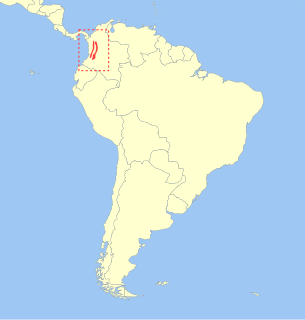
The rodent subfamily Sigmodontinae includes New World rats and mice, with at least 376 species. Many authorities include the Neotominae and Tylomyinae as part of a larger definition of Sigmodontinae. When those genera are included, the species count numbers at least 508. Their distribution includes much of the New World, but the genera are predominantly South American, such as brucies. They invaded South America from Central America as part of the Great American Interchange near the end of the Miocene, about 5 million years ago. Sigmodontines proceeded to diversify explosively in the formerly isolated continent. They inhabit many of the same ecological niches that the Murinae occupy in the Old World.
Philip Myers's akodont is a recently described species of grass mouse from Misiones Province, Argentina. Like other grass mice, A. philipmyersi is a small, non-descript, greyish-brown mouse with prominent ears. The species was recognized as distinct from other grass mice on the basis of unique features of karyology, genetic sequence, cranial measurements, and general morphology.
The cursor grass mouse or cursorial akodont, is a sigmodontine rodent from South America.
Akodon aerosus, also known as the highland grass mouse or Yungas akodont, is a species of rodent in the family Cricetidae. It is found in the eastern Andes from eastern Ecuador through Peru into central Bolivia.

Akodon affinis, also known as the Colombian grass mouse or Cordillera Occidental akodont, is a species of rodent in the family Cricetidae. It is found only in the Cordillera Occidental of Colombia.
Akodon albiventer, also known as the white-bellied grass mouse or white-bellied akodont, is a species of rodent in the family Cricetidae. It is found in the Andean highlands from southeastern Peru to southwestern Bolivia, northwestern Argentina, and far northeastern Chile at elevations from 2400 m to over 5000 m.
Akodon boliviensis, also known as the Bolivian grass mouse or Bolivian akodont, is a species of rodent in the family Cricetidae. It is found in the Andes from southeastern Peru through Bolivia into northwestern Argentina.
The smoky grass mouse is a species of rodent in the family Cricetidae. It is found in Argentina, Bolivia and Peru.
The Junín grass mouse is a species of rodent in the family Cricetidae. It is found only in Peru.
Koford's grass mouse is a species of rodent in the family Cricetidae. It is found only in Peru. It is named after American biologist Carl B. Koford.
The Neuquén grass mouse is a species of rodent in the family Cricetidae. It is found only in Argentina. As of 2017, the IUCN synonymizes it with Akodon dolores.
The Altiplano grass mouse is a species of rodent in the family Cricetidae. It is found in Bolivia, and Peru.
The Cochabamba grass mouse is a species of rodent in the family Cricetidae. It is found only in Bolivia. Its natural habitat is subtropical or tropical moist lowland forests.

Akodon spegazzinii, also known as Spegazzini's akodont or Spegazzini's grass mouse, is a rodent in the genus Akodon found in northwestern Argentina. It occurs in grassland and forest at 400 to 3,500 m above sea level. After the species was first named in 1897, several other names were given to various populations now included in A. spegazzinii. They are now all recognized as part of a single, widespread and variable species. Akodon spegazzinii is related to Akodon boliviensis and other members of the A. boliviensis species group. It reproduces year-round. Because it is widely distributed and common, Akodon spegazzinii is listed as "least concern" on the IUCN Red List.
The Puno grass mouse is a species of rodent in the family Cricetidae. It is found in Bolivia and Peru.

Akodon sylvanus, also known as the forest grass mouse or woodland akodont, is a species of rodent in the family Cricetidae. It is found only in a small part of northwestern Argentina.
The cloud forest grass mouse is a species of rodent in the family Cricetidae. It is found only in Peru.
The variable grass mouse is a species of rodent in the family Cricetidae. It is known only from Bolivia, where it is found at elevations from 400 to 3000 m.
The Andean vesper mouse is a species of rodent in the family Cricetidae. It is found in Argentina, Bolivia, Chile, and Peru.
Oxymycterus hucucha, also known as the Quechuan Hocicudo, is a species of rodent in the genus Oxymycterus of family Cricetidae from South America. It is found only in a small region of the Andes in central Bolivia, where it lives in cloud forest at altitudes from 2600 to 3000 m.




